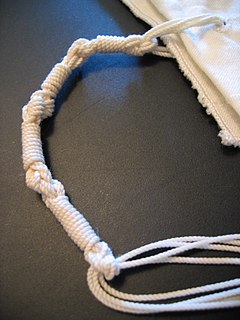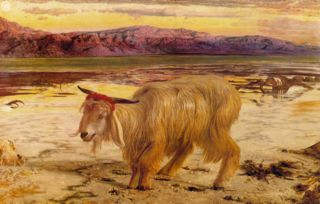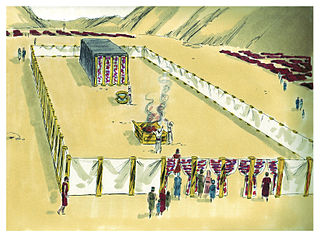Related Research Articles
Kashrut is a set of dietary laws dealing with the foods that Jews are permitted to eat and how those foods must be prepared according to Jewish law. Food that may be consumed is deemed kosher, from the Ashkenazic pronunciation (KUHsher) of Hebrew kashér, meaning "fit".

The Torah is the compilation of the first five books of the Hebrew Bible, namely the books of Genesis, Exodus, Leviticus, Numbers and Deuteronomy. In that sense, Torah means the same as Pentateuch or the Five Books of Moses. It is also known in the Jewish tradition as the Written Torah. If meant for liturgic purposes, it takes the form of a Torah scroll. If in bound book form, it is called Chumash, and is usually printed with the rabbinic commentaries.
In its primary meaning, the Hebrew word mitzvah refers to a commandment commanded by God to be performed as a religious duty. Jewish law in large part consists of discussion of these commandments. Traditionally, it is held that there are 613 such commandments.

Kodashim is the fifth of the six orders, or major divisions, of the Mishnah, Tosefta and the Talmud, and deals largely with the services within the Temple in Jerusalem, its maintenance and design, the korbanot, or sacrificial offerings that were offered there, and other subjects related to these topics, as well as, notably, the topic of kosher slaughter of animals for non-sacrificial purposes.
In Judaism, the korban, also spelled qorban or corban, is any of a variety of sacrificial offerings described and commanded in the Torah. The plural form is korbanot, korbanoth or korbans.

Tzitzit are specially knotted ritual fringes, or tassels, worn in antiquity by Israelites and today by observant Jews and Samaritans. Tzitzit are usually attached to the four corners of the tallit gadol, usually referred to simply as a tallit or tallis; and tallit katan. Through synecdoche, a tallit katan may be referred to as tzitzit.

Kosher foods are those foods that conform to the Jewish dietary regulations of kashrut, the Jewish dietary law is primarily derived from Leviticus 11 and Deuteronomy 14:1-21. Foods that may be consumed according to halakha are termed kosher in English, from the Ashkenazi pronunciation of the Hebrew term kashér, meaning "fit". Foods that are not in accordance with Jewish law are called treif meaning "torn."
Sefer Hamitzvot is a work by the 12th century rabbi, philosopher and physician Maimonides. While there are various other works titled similarly, the title "Sefer Hamitzvot" without a modifier refers to Maimonides' work. It is a listing of all the commandments of the Torah, with a brief description for each.

Acharei Mot is the 29th weekly Torah portion in the annual Jewish cycle of Torah reading. It is the sixth weekly portion in the Book of Leviticus, containing Leviticus 16:1–18:30. It is named after the fifth and sixth Hebrew words of the parashah, its first distinctive words.

Emor is the 31st weekly Torah portion in the annual Jewish cycle of Torah reading and the eighth in the Book of Leviticus. The parashah describes purity rules for priests, recounts the holy days, describes the preparations for the lights and bread in the sanctuary, and tells the story of a blasphemer and his punishment. The parashah constitutes Leviticus 21:1–24:23. It has the most verses of any of the weekly Torah portions in the Book of Leviticus, and is made up of 6,106 Hebrew letters, 1,614 Hebrew words, 124 verses and 215 lines in a Torah Scroll.
In Jewish law, ṭumah and ṭaharah are the state of being ritually "impure" and "pure", respectively. The Hebrew noun ṭum'ah, meaning "impurity", describes a state of ritual impurity. A person or object which contracts ṭumah is said to be ṭamé, and thereby unsuited for certain holy activities and uses until undergoing predefined purification actions that usually include the elapse of a specified time-period.

Kosher animals are animals that comply with the regulations of kashrut and are considered kosher foods. These dietary laws ultimately derive from various passages in the Torah with various modifications, additions and clarifications added to these rules by halakha. Various other animal-related rules are contained in the 613 commandments.
In Judaism, views on abortion draw primarily upon the legal and ethical teachings of the Hebrew Bible, the Talmud, the case-by-case decisions of responsa, and other rabbinic literature. While all major Jewish religious movements allow abortion in order to save the life or health of a pregnant woman, authorities differ on when and whether it is permitted in other cases.
Mixtures of milk and meat are forbidden according to Jewish law. This dietary law, basic to kashrut, is based on two verses in the Book of Exodus, which forbid "boiling a (goat) kid in its mother's milk" and a third repetition of this prohibition in Deuteronomy.

Chelev, or what is also known as "suet", is the animal fats that the Torah prohibits Jews and Israelites from eating. Only the chelev of animals that are of the sort from which offerings can be brought in the Tabernacle or Temple are prohibited. The prohibition of eating chelev is also, in addition to the Torah, one of the 613 commandments that, according to the Talmud, were given to Moses on Mount Sinai.
Forbidden relationships in Judaism are intimate relationships which are forbidden by prohibitions in the Torah or rabbinical injunctions.
The firstborn or firstborn son is an important concept in Judaism. The role of firstborn son carries significance in the redemption of the first-born son, in the allocation of a double portion of the inheritance, and in the prophetic application of "firstborn" to the nation of Israel.
In the Tanakh, the term herem is used, among other meanings, for an object or real property to be devoted to God, with God authorizing a kohen to be its receiving agent.

Leviticus 19 is the nineteenth chapter of the Book of Leviticus in the Hebrew Bible or the Old Testament of the Christian Bible. It contains laws on a variety of topics, and is attributed by legend to Moses.
In Jewish law, a ben pekuah is an animal fetus removed alive from its mother, shortly after the mother was slaughtered in conformance with the rules of shechita. According to Jewish law, a ben pekuah may later be slaughtered for consumption without adhering to shechita.
References
- ↑ Nahum M. Sarna, Chaim Potok, The JPS Torah Commentary: Leviticus Jewish Publication Society 1989 Page 113 "In 22:26f., for example, in a formulation identical to that found here, we read that the offspring of large and small cattle may not be "slaughtered" until the eighth day after birth, at which time they first become acceptable as sacrifices. In keeping ..."
- ↑ Gesenius Hebrew Lexicon "Showr ...This is the general word for one of the ox tribe... without distinction of age or sex"
- ↑ Ben Zion Wacholder The New Damascus Document: The Midrash On The Eschatological Torah 2007 Page 296 "And an ox or a lamb with its offspring you may not slaughter at the same time. And you shall not strike the mother with her offspring. (11QT 52:5–7a) This text diverges from Talmudic tradition. According to the sages, the prohibition against slaughtering a young calf extends from birth to the seventh day of its life (Hullin 78:2). However, Temple Scroll, by linking Lev 22:28 and a paraphrase of Gen 32:12 which contains the phrase ... in the context of Jacob fearing that Esau might strike him together with all of his clan, suggests that b-yom ehad means “at the same time." In other words it is prohibited to slaughter a fetus when it is in its mother's womb."
- ↑ Ben Zion Wacholder The New Damascus Document: The Midrash On The Eschatological Torah 2007 Page 296 "3.2.2.9.6.2.7. The Status of a Fetus (4Q270 F2ii:15b) As we have stated above, the prohibition against slaughtering a pregnant animal differs from rabbinic tradition which sanctions it. On this ban, see also 11QT 52:5–7a: yl hmh hbowt yk twalm ..."
- ↑ William R. G. Loader The Dead Sea Scrolls on Sexuality 2009 - Page 140 "... the prohibition against slaughtering a pregnant animal in what immediately precedes (ii.15), an application of Deut 22:6, as in 11QTa/11Q19 52.5, there, applied to sacrificial slaughter, and similarly in 4QMMTB 36-38, and to 11QTa/11Q19 ..."
- ↑ John Kampen, Moshe J. Bernstein Reading 4QMMT: new perspectives on Qumran law and history 1996 - Page 40 "The uniqueness of the Qumran treatment, according to Qimron's restoration, is the association of Lev 22:28 with the prohibition against slaughtering a pregnant animal and the requirement to slaughter a fetus found alive in the womb of its "
- ↑ Jacob Milgrom, David Pearson Wright, David Noel Freedman Pomegranates and Golden Bells: Studies in Biblical, Jewish, and Near Eastern Ritual, Law, and Literature in Honor of Jacob Milgrom 1995 "... there is apparently also a prohibition of consuming the young of an animal found alive within the womb of its mother. The young is regarded as a distinct animal requiring its own ritual slaughter.7"
- ↑ Greek Septuagint Leviticus 22:28 καὶ μόσχον ἢ πρόβατον αὐτὴν καὶ τὰ παιδία αὐτῆς οὐ σφάξεις ἐν ἡμέρᾳ μιᾷ
- ↑ Thayer Greek Lexicon moschos "Septuagint chiefly for a bull, especially a young bull, then for cattle, for an ox or a cow, for a calf"
- ↑ Commentary on Mishna Chullin 5:1 et al.
- ↑ Commentary to Leviticus 22:28
- ↑ Commentary to Leviticus 22:28
- ↑ Yoreh Deah 16:2
- ↑ Talmud Hullin 83a